soziale stadt - bundestransferstelle
besonderem Entwicklungsbedarf - Soziale Stadt"
Halle Silberhöhe |
|||||||
|
Stefan Geiss |
|||||||
1. Nature of the Area 
In comparison with other panel-construction housing estates in East Germany, Halle-Silberhöhe is a very large, very young, and very dense residential area. The 239 hectare district was built between 1979 and 1989 by the prefabricated large-panel construction method for the workforce of the chemicals combines BUNA and LEUNA on largely agricultural land on the southern fringes of the city. At the date of reunification some 39,000 people were accommodated in the over 15,000 dwellings. Silberhöhe is the mostly densely developed district of Halle.
Separated from the rest of the city by a suburban railway line and surrounded on many sides by fields and village settlement areas, Silberhöhe is a detached district scarcely linked with the rest of the municipal territory. The most striking urban landmarks are two 22 storey tower blocks in the northern part of the estate.
Silberhöhe is divided into so-called residential complexes. The term "residential complex" is, however, misleading, because although the built-up areas are marked off by green space corridors and streets, they are not functionally independent or architecturally differentiated units. Basically two urban development situations can be distinguished: first, heavily built-up areas with eleven-storey buildings, largely on the periphery of the residential complexes, and, second, less dense, green residential areas with five-storey buildings in the interior of the residential complexes. Public infrastructure facilities are integrated into the residential complexes.
 |
| Halle-Silberhöhe - central green space corridor (Source: Halle Municipality, Municipal Surveying Board) |
Although a small district centre had been planned and to some extent realised in the northern part of the estate, with public squares, rows of shops, and other public facilities, it can now fulfil its function only to a limited degree in view of the size of the estate, despite "modernisation" in the form of pavilion-like shop buildings. Much of the retail trade is handled by several large-surface retail outlets that were constructed after the change of regime on the fringes of the district.
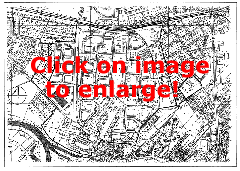 |
Boundaries of the model area (Source: empirica, Berlin) |
In many neighbourhoods of the district there is meanwhile a very high vacancy rate. Some buildings, especially in the more heavily built-up areas, are completely vacant. Often this is associated with a loss of image for individual parts of the estate and for the estate as a whole. The modernised five-storey buildings are less affected.
2. Main Problems and Development Potential 
Halle-Silberhöhe is a large-scale housing estate typical of the new federal states. Built in response to the acute housing shortage in the late phase of the GDR, it proved to have structural shortcomings from the outset. The originally planned density of development was exceeded. At the same time, the district was not completed; e.g., the southern centre, which was to have accommodated a large part of commercial facilities was not fully realised. The monofunctionality of the district as a purely residential area is tangible in Halle-Silberhöhe to this day, apparent, for example in the inadequate infrastructure - especially the lack of retail outlets. In GDR times, dwellings in Silberhöhe were highly prized - being well equipped and modern in comparison to old housing stock. A home in a new housing block was the dream of many households. The social mix in the residential area was accordingly "good." Given the comparatively late date of occupancy (between 1979 and 1989), however, many tenants and cooperative members had only weak "ties" with the district.
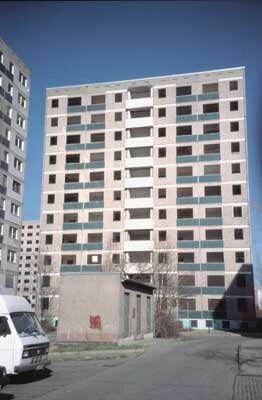 |
Waiting for demolition - Vacated eleven-storey block (Source: empirica, Berlin) |
And in the first years after the change in regime many people in positions of responsibility assumed that panel-construction housing would retain its high status in the housing supply. However, in the second half of the 1990s it became apparent that, in parallel to the strong expansion of the housing supply through new construction and rehabilitation, the supply of new residential forms and the economic attractiveness of other regions was leading to a considerable exodus from Silberhöhe. In all housing estates of this type, the consequent vacancies constitute the biggest problem. They affect not only landlords, who must often fear for their economic survival, but also tenants. Residents have to come to terms with living in half-empty buildings, and they experience how recently provided service amenities disappear again owing to dwindling purchasing power.
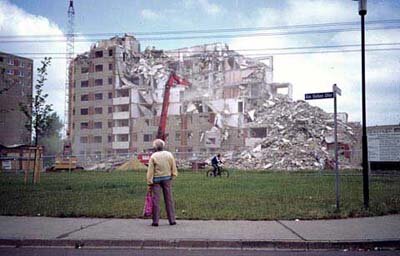 |
Pilot project for demolition (Source: empirica, Berlin) |
Imperceptibly at first, changes in the function and status of Silberhöhe have also triggered massive social changes. The loss of population was far higher in Halle-Silberhöhe than the figures show. New tenants have moved into almost every second vacant apartment. Of course, not every (new) tenant in Silberhöhe is economically worse off than the average for Halle, and the number of people inclined towards socially deviant behaviour as a result of joblessness and uprooting is certainly small in absolute terms, but the increasing vacancy rate and high tenant fluctuation is a clear indication that Silberhöhe has developed into a problem district. Household incomes are low, and the proportion of social assistance recipients is the highest in Halle.
Demography and social-space
|
Silberhöhe |
Halle |
|
|
Size |
204 ha |
13 499 ha |
|
Population |
22 125 |
246 450 |
|
Population decline (1995–2000) |
37.3 % |
12.7 % |
|
Average household size |
n.a. |
1.98 pers. |
|
Number of dwellings |
15 215 |
151 443 |
|
Vacancy rate |
22.4 % |
n.a. |
|
Housing benefit recipients |
n.a. |
20 016 |
|
Unemployment rate |
28.0 % |
20.9 % |
|
Social assistance recipients |
10.7 % |
7.2 % |
|
Foreign population |
3.2 % |
3.1 % |
|
Population under 18 |
18.5 % |
16.0 % |
|
Population 60 and older |
21.3 % |
24.6 % |
Regardless of the social changes that have taken place among residents, the declining attractiveness of Silberhöhe as a place to live has become a problem for the district. Of the 15,215 dwellings, 3,440 were vacant in June 2000. This is a vacancy rate of 22.6%. Most of the empty apartments are concentrated in the P2 type eleven-storey blocks, which are particularly unattractive owing to their unfavourable ground plans and the large number of dwellings per stairwell. The vacancy problem has triggered a highly emotional, city-wide discussion on redevelopment and complete demolition.
In the meantime, housing companies, the municipality, and the area management have agreed that Halle-Silberhöhe can be stabilised only if some of the housing stock no longer required is demolished. From the point of view of the actors, the district as a whole can be saved only if it can be restructured with lower densities, much reduced in overall size, and by concentrating on the more attractive areas. Scaling-down should ideally be accompanied by attractive substitute uses for the vacated property. The district would then benefit more strongly than before from the landscape quality of the environs and its proximity to the Salle-Elster bottomland. In a pilot project launched last year, the first eleven-storey blocks have already been demolished.
Consensus has now been reached in the context of the urban development concept "Living" on the initial need to demolish about 2,200 dwellings in Halle-Silberhöhe - exclusively in eleven-story blocks in defined demolition zones. In a second phase, a further 2,300 dwellings are to be demolished. According to the development plan, a total of 4,500 dwellings are to be demolished, about one third of the total housing stock in Halle-Silberhöhe, representing some two-thirds of the vacancy figure predicted up to 2010.
3. Development Goals and Focal Points of Action 
There is far-reaching agreement that Silberhöhe cannot be conserved in its current dimensions and structure because the overall demand for housing is too low. Various forecasts by the municipality indicate that the vacancy problem will grow over time in the city as a whole. As an outcome of city-wide master planning and the resulting assessment of Silberhöhe's chances on the overall housing market, it is now assumed that, owing to its locational qualities, Silberhöhe will be worse hit than other areas by vacancies and, consequently, by scaled-down redevelopment.
The re-organisation concept for the development of the district is being adjusted accordingly. It comprises a framework plan for Halle-Silberhöhe, which lays down guidelines and development goals for urban development, infrastructure, and the reduction of housing surpluses (demolition). The following area types are defined: priority areas: "conservation before demolition" (divided into consolidation areas and restructuring areas with demolition measures in specific cases) and subordinate areas: "demolition before conservation" (divided into demolition zones and zones in which demolition is likely in the long term).
The development of the northern centre is considered an important element in consolidating the district. Planning for open spaces has been contracted out, and a concept also exists for urban development, which is to be implemented jointly with the housing company. From the viewpoint of the municipality, the northern centre is the best place to increase the range of available dwelling ground plans through scaled-down redevelopment, and to counteract social segregation by differentiating the housing supply. The substance of this planning is based on the integrated plan of action, and is part of the overall strategy for Halle-Silberhöhe. There is no formal legal link with the integrated plan of action.
A conversion process that will take years to complete can be organised and implemented only in collaboration with all important economic and societal groups. For this reason the municipality and property owners therefore came together at a relatively early date in bodies where appropriate strategies could be discussed and prepared. This has been the case for the city as a whole and for the district of Silberhöhe. The aim of all measures is to give Silberhöhe a new image through a combination of partial demolition and the upgrading of remaining stock, and by improving the infrastructure. It is hoped to bring Silberhöhe to the attention of the population (again) as an attractive residential location.
It is difficult to define the fields within so complex a strategy for Halle-Silberhöhe that are explicitly attributable to the "Socially Integrative City" programme. Interaction between general policy notions in urban development and the housing market is too interlinked. However, there can be no question that both the work of the area management and specific projects financed by the "Socially Integrative City" programme have addressed important tasks.
They include, in the long term, socially acceptable support for the urban redevelopment process, and, in the short term, the improvement of living conditions in the district. Deficiencies have been identified especially in child and youth services for residents, so that this area has been a major focus for measures in this field. The problem of youth unemployment, in particular, is a major short-term challenge.
4. Key Projects 
Given the necessity for immediate action, key projects going beyond urban renewal, and which are closely associated with the "Socially Integrative City" programme, have mainly been concerned with the needs of children and young people and with infrastructural shortcomings. These projects have often been coupled with substitute uses for vacant premises.
One example is the "Youth Catering Enterprise" shortly to be launched. Former youth club premises are being converted into a café and restaurant, which will offer inexpensive food and drink for a "less well-off" public. The establishment will be run by a youth enterprise, which will employ 20 young people, most of them from Halle-Silberhöhe, who, having successfully completed vocational training in catering trades, have been jobless. They will be able to gain first professional experience in this undertaking. The project is financed by the federal government youth immediate action programme (JusoPro as an element of the "Job-Active Act"). On the basis of the experience they gain, the young people will be able to look for work in the primary labour market, thus using the enterprise as a springboard.
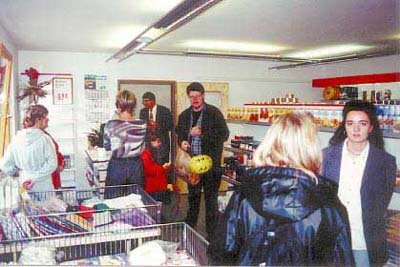 |
Opening of the Carisatt Shop in October 2000 (Source: S.T.E.R.N. GmbH, Berlin) |
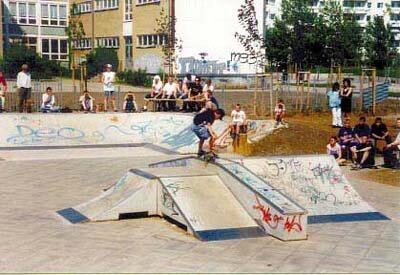 |
The skate spot - a new facility for young people in the district (Source: S.T.E.R.N. GmbH, Berlin) |
Another project is the conversion of the former "Club of Innovators" into a "Carisatt Centre." In the framework of a job creation scheme, the building initially intended for demolition is to be transformed into a shop. People entitled to buy can obtain discounted convenience articles. The goods on sale are products that are not on offer in the normal supermarket product range because, for example, they have been slightly damaged in transport. The shop was handed over to the Catholic charity organisation Caritas and opened for business in October 2000.
Besides these key projects, the services for children and young people in the district have been substantially improved through numerous important, albeit smaller projects. Particularly worth mentioning are skate spots, streetball courts, two student cafés, the design of an open school playground, and the establishment of so-called "hangouts" for young people.
The cooperative projective initiated by empirica involving housing companies, employment agencies, educational establishments, and the employment office takes a different approach. The core elements of the project are so-called service stations, in which 15 jobless young people offer diverse services for the residential area, residents, and the housing companies (additional cleaning, damage assessment, smaller repairs, shopping help, etc.). The main aim of the project is to stabilise the deprived residential neighbourhood, while giving disadvantaged young people hit by unemployment an occupational perspective through qualification under a job creation scheme.
5. Organisation and Management 
Administrative level
Planning, coordination, and implementation are in the hands of the municipal planning authority in collaboration with S.T.E.R.N. Gesellschaft der behutsamen Stadterneuerung mbH. A member of the city planning authority, a landscape architect initially in charge of the municipal residential environment programme, has meanwhile taken over coordination within the administration. In addition, a high proportion of the project conceptual work is concentrated here. The municipal planning authority coordinates applications, financial planning, and the processing of committee and council documents on the "Socially Integrative City" programme.
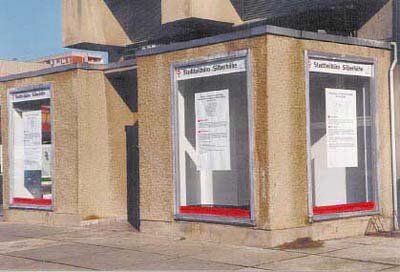 |
The District Bureau (Source: S.T.E.R.N. GmbH, Berlin) |
Intermediary level
Since 1999 S.T.E.R.N. GmbH has been taken on planning, activation, and coordination functions in the context of the district management for Silberhöhe. It prepared the plan of action for the Halle municipality, supports the municipality in project initiation and implementation, and acts more or less as the "executive branch" of the municipal planning authority. Since 1999 it has moderated the "Silberhöhe working party," which was set up by the first district conference in November 1998. S.T.E.R.N. also moderates the municipal steering group.
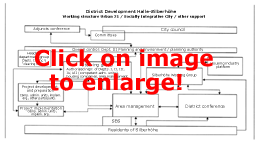 |
Organisation of programme implementation |
The Silberhöhe working party, which meets every three of four months, "is an advisory body bringing together administrative authorities, interest groups, and institutions. Its aim is to participate actively in the development of Silberhöhe district. This includes collaborating in the formulation and application of development goals and coordinating priorities for measures to be taken in the district." (excerpt from the rules of procedure). In practice, the working party is particularly responsible for information and networking functions. It is comprised by representatives of almost all the relevant actors: associations, clubs, civic action groups, commercial establishments, housing companies, public utilities, the Saxony-Anhalt Ministry of Housing, Urban Development and Transport, political parties, the competent units of the Halle Departments for Planning, Environment/Culture, Education and Sport, Youth, Social Affairs and Health, the Office for Public Order, the Building Construction Office, and, since the last meeting, the Office for the Promotion of Trade and Industry; only the Finance Department is not involved.
Local level
The big district conference organised by the district management takes place once or twice a year. Residents and actors discuss measures and the status of planning . Citizens can also directly inform those in positions of responsibility in the municipality about their problems and wishes. Just how important these district conferences are is shown by the fact that the last conference, which the mayor attended, decided what projects were to be implemented in the district.(1) The results of the conference flowed directly into a draft for the city council and was subsequently adopted by the council.
The S.T.E.R.N. GmbH has important information and activation functions in the District Bureau. Since February 2001, the municipality has provided a job-creation scheme position for the bureau, which can consequently open almost daily. In issue-specific consultation and in informal group discussions (Open Citizens' Circle, Business People's Circle, Private Institutions Circle) both individuals and groups of resident and actors are integrated in the development of the district. The district management organises the dialogue between various actors, so that common development priorities are set and all important groups are tied into the decision-making process. Furthermore, the district management engages in public relations work to gain the understanding of the population for the need for urban redevelopment. The first successes achieved in district renewal have also been publicised.
Urban development is coordinated between housing companies and municipality by the Halle-Silberhöhe working group set up by the Silberhöhe housing companies, which belongs to the "Living in Halle" network. This network was established in 1999 on the initiative of the housing cooperatives and companies in Halle. It is concerned with cross-company issues of housing vacancies and urban redevelopment. The core element is the so-called housing industry platform, on which two municipal and eleven private housing cooperatives are currently represented. On the basis of this platform, area-specific working groups have been set up for the four big new housing areas and the Halle inner city.
6. Activation, Participation, and Public Relations 
An effort is made at several levels in Halle-Silberhöhe district to involve residents and actors in the process of district development (the information level, the networking, coordination and planning level, and the project implementation level).
Information level
At the superordinate information level, public relations in the form of a quarterly district magazine, press releases for the local media, and brochures on various subjects (e.g., Silberhöhe shopping guide," "List of Silberhöhe Clubs and Associations,") inform residents about developments and planning in the district. A monthly calendar of events draws attention to what is going on locally.
Networking, coordination and planning level
The networking and coordination of planning takes places formally and informally in discussion between municipal officials, the district management, district actors and residents in the organisational structures established for this purpose.
Project implementation
At the concrete implementation level an attempt is made to integrate interested residents in project planning and realisation. The following forms of activation and participation can be specifically identified:
- Open Citizens' Circle: the Open Citizens' Circle is a relatively new institution organised by the area management. It takes place once a month in the District Bureau. In a relaxed atmosphere, residents can discuss developments in the district with representatives of the district management and put forward their suggestions and reservations.
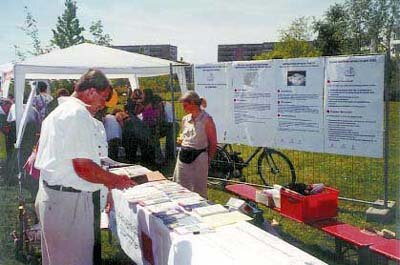 |
Area management infostand at the district festival (Source: S.T.E.R.N. GmbH, Berlin) |
- District conferences: since 1998 a total of four district conferences have take place in Silberhöhe. They have given local actors a regular opportunity to discuss current problems in the district and better to coordinated their various activities. Each district conference, announced in the local daily press and the district newspaper, has attracted some 200 participants from Halle-Silberhöhe.
- Project with a group of school students: the district was constantly plagued by conflicts because of "loitering" young people, since there is a lack of recreational and sojourn facilities for youth in the district. On the initiative of the municipality and the area management, the "Student Project Group WK VII" has been set up, which, under the guidance of the municipality and the care of a school social educationalist, has elaborated a comprehensive play and recreation concept for their housing complex. In retrospect, however, the citywide discussion on redevelopment came to the conclusion that WK VII was not among the areas worth conserving. For this reason only parts of the concept developed by the young people were realised.
7. |
Conclusion and Prospects: "Socially Integrative City" as an Engine for Cooperation in Urban Redevelopment
|
In Halle-Silberhöhe changes are taking place in dimensions and at a speed far greater than any experienced in the past or in other housing estates. It is accordingly difficult to answer the question whether the "Socially Integrative City" programme or the strategies pursued can stabilise the situation as a whole . There is no doubt, however, that the holistic district-specific approach triggered by the programme has been a major factor in the high level of cooperativeness between municipality, housing industry, and interested citizens. Both planning for restructuring and the implemented and envisaged projects have created an atmosphere in which important actors work together to find solutions for the district and its population.
In order to solve all the problems resulting from the declining acceptance of the residential location and the concomitant concentration of difficulties for residents, landlords, housing companies, and public institutions, both greater cooperation and more "radical" decisions are required. Numerous difficulties still have to be overcome in organising the contractionary process - for example, burden sharing between housing companies differentially affected by redevelopment and appropriate removal management for tenants. At the same time, improving the direct activation of residents and their integration in projects to combat frequently apparent discouragement is a laborious task that requires much goodwill on all sides. In Silberhöhe, the schools, employment offices, public authorities, and business enterprises must by integrated more intensively than before in district work. The notion that the "Socially Integrative City" is a programme under which government plans and implements individual projects to improve the infrastructure is still far too widespread among the public. This is to be attributed not least of all to a lack of flexibility in the employment of programme funds and the frequently lengthy allocation process. Particularly in the case of complex measures and multiple-source project funding, paralysing procedures often result that make it extremely difficult to employ bundled resources.
References
(1) In the course of applying for support from the state "Urban 21" programme, many project ideas were developed for Halle-Silberhöhe. Owing to the rejection of the application, only a fraction of the projects can now be realised with funding from the "Socially Integrative City" and "Further Development of Large New Housing Areas" programmes. ![]()
Im Auftrag des BMVBS vertreten durch das BBR. Zuletzt geändert am 25.05.2005